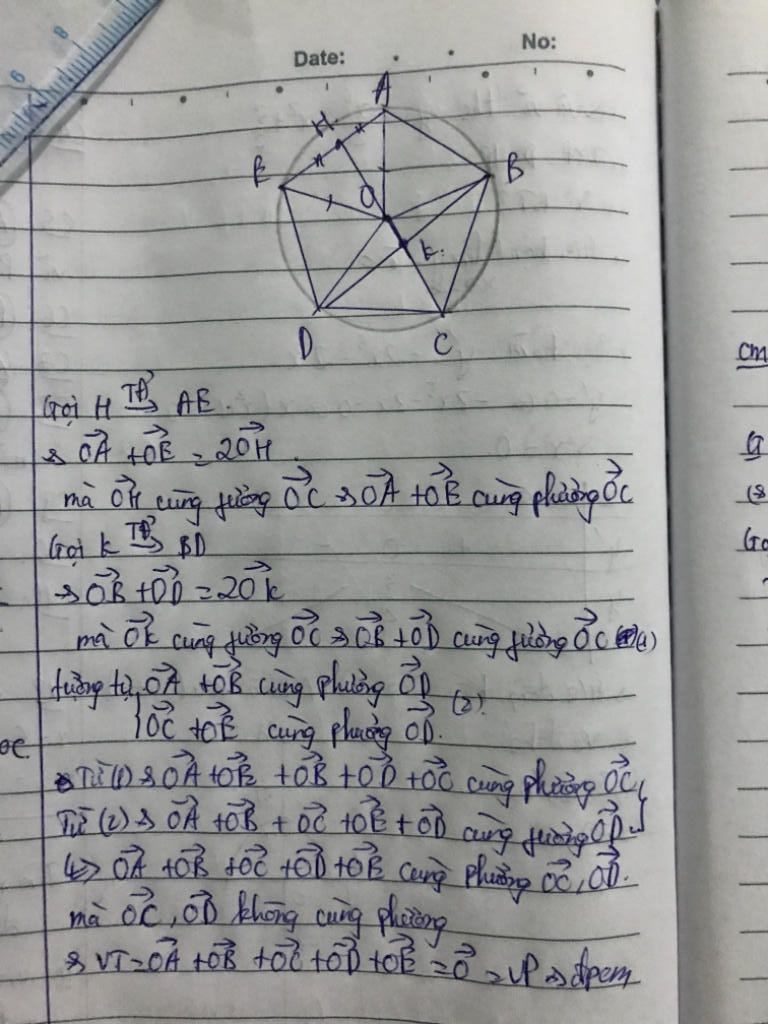Hãy nhập câu hỏi của bạn vào đây, nếu là tài khoản VIP, bạn sẽ được ưu tiên trả lời.

1.
Gọi G là trọng tâm tam giác
\(\overrightarrow{OA}+\overrightarrow{OB}+\overrightarrow{OC}=\overrightarrow{0}\)
\(\Leftrightarrow3\overrightarrow{OG}=\overrightarrow{0}\)
\(\Leftrightarrow O\equiv G\)
\(\Rightarrow O\) là trọng tâm tam giác ABC
\(\Rightarrow\Delta ABC\) đều
Gọi độ dài các cạnh tam giác là a
\(\overrightarrow{BN}.\overrightarrow{AM}=\dfrac{1}{4}\left(\overrightarrow{AB}+\overrightarrow{AC}\right)\left(\overrightarrow{BA}+\overrightarrow{BC}\right)=-\dfrac{1}{4}a^2-\dfrac{1}{8}a^2-\dfrac{1}{8}a^2+\dfrac{1}{2}a^2=0\)
Mặt khác \(\overrightarrow{BN}.\overrightarrow{AM}=BN.AM.cos\left(\overrightarrow{AM};\overrightarrow{BN}\right)\)
\(\Rightarrow BN.AM.cos\left(\overrightarrow{AM};\overrightarrow{BN}\right)=0\Rightarrow cos\left(\overrightarrow{AM};\overrightarrow{BN}\right)=0\Rightarrow\left(\overrightarrow{AM};\overrightarrow{BN}\right)=90^o\)
\(BD=\dfrac{AB}{cos45^o}=\dfrac{a}{\dfrac{\sqrt{2}}{2}}=a\sqrt{2}\)
\(\overrightarrow{BQ}.\overrightarrow{BP}=\dfrac{1}{4}\left(\overrightarrow{BA}+\overrightarrow{BD}\right)\left(\overrightarrow{BC}+\overrightarrow{BD}\right)\)
\(=\dfrac{1}{4}BA.BC.cos90^o+\dfrac{1}{4}BA.BD.cos45^o+\dfrac{1}{4}BD.BC.cos45^o+\dfrac{1}{4}BD^2\)
\(=\dfrac{1}{4}a^2+\dfrac{1}{4}a^2+\dfrac{1}{2}a^2=a^2\)

1)Điều kiện: \(x + y > 0\)\((1) \Leftrightarrow (x + y)^2 - 2xy + \dfrac{2xy}{x + y} - 1 = 0 \\ \Leftrightarrow (x + y)^3 - 2xy(x + y) + 2xy -(x + y) = 0 \\ \Leftrightarrow (x+y)[(x+y)^2- 1]-2xy(x+y-1)=0 \\ \Leftrightarrow (x+y)(x+y+1)(x+y-1)-2xy(x+y-1)=0 \\ \Leftrightarrow (x + y - 1)[(x+y)(x + y + 1)-2xy] = 0 \\ \Leftrightarrow \left[ \begin{matrix}x + y = 1 \,\, (3) \\ x^2+y^2+x+y=0 \,\, (4) \end{matrix} \right.\)(4) vô nghiệm vì x + y > 0
Thế (3) vào (2) , giải được nghiệm của hệ :\((x =1 ; y = 0)\)và \((x = -2 ; y = 3)\)
\((1)\Leftrightarrow (x-2y)+(2x^3-4x^2y)+(xy^2-2y^3)=0\)\(\Leftrightarrow (x-2y)(1+2x^2+y^2)=0\)
\(\Leftrightarrow x=2y\)(vì \(1+2x^2+y^2>0, \forall x,y\))
Thay vào phương trình (2) giải dễ dàng.

Gt ⇒ \(2\left|\overrightarrow{MC}+\overrightarrow{MA}+\overrightarrow{MB}\right|=3\left|\overrightarrow{MB}+\overrightarrow{MC}\right|\)
Do G là trọng tâm của ΔABC
⇒ \(\overrightarrow{MA}+\overrightarrow{MB}+\overrightarrow{MC}=3\overrightarrow{MG}\)
⇒ VT = 6MG
I là trung điểm của BC
⇒ \(\overrightarrow{MA}+\overrightarrow{MB}=2\overrightarrow{MI}\)
⇒ VP = 6MI
Khi VT = VP thì MG = MI
Vậy tập hợp các điểm M thỏa mãn ycbt là đường trung trực của đoạn thẳng IG

5,\(hpt\Leftrightarrow\left\{{}\begin{matrix}x\left(x+y\right)\left(x+2\right)=0\\2\sqrt{x^2-2y-1}+\sqrt[3]{y^3-14}=x-2\end{matrix}\right.\)
Thay từng TH rồi làm nha bạn
3,\(hpt\Leftrightarrow\left\{{}\begin{matrix}x-y=\frac{1}{x}-\frac{1}{y}=\frac{y-x}{xy}\\2y=x^3+1\end{matrix}\right.\)
\(\Leftrightarrow\left\{{}\begin{matrix}\left(x-y\right)\left(1+\frac{1}{xy}\right)=0\\2y=x^3+1\end{matrix}\right.\)
thay nhá
Bài 1:ĐKXĐ: \(2x\ge y;4\ge5x;2x-y+9\ge0\)\(\Rightarrow2x\ge y;x\le\frac{4}{5}\Rightarrow y\le\frac{8}{5}\)
PT(1) \(\Leftrightarrow\left(x-y-1\right)\left(2x-y+3\right)=0\)
+) Với y = x - 1 thay vào pt (2):
\(\frac{2}{3+\sqrt{x+1}}+\frac{2}{3+\sqrt{4-5x}}=\frac{9}{x+10}\) (ĐK: \(-1\le x\le\frac{4}{5}\))
Anh quy đồng lên đê, chắc cần vài con trâu đó:))
+) Với y = 2x + 3...

2.
Ta cần tìm \(cosABC=\dfrac{AB^2+BC^2-AC^2}{2AB.BC}=\dfrac{3\left(AB^2+BC^2-AC^2\right)}{2AC^2}\)
Gọi H, K là trung điểm của AB, BC.
Theo giả thiết \(\overrightarrow{OM}\perp\overrightarrow{BI}\)
\(\Rightarrow\overrightarrow{OM}.\overrightarrow{BI}=0\)
\(\Leftrightarrow\left(2\overrightarrow{OA}+\overrightarrow{OB}+2\overrightarrow{OC}\right)\left(\overrightarrow{BA}+\overrightarrow{BC}\right)=0\)
\(\Leftrightarrow\left(2\overrightarrow{OB}+2\overrightarrow{BA}+\overrightarrow{OB}+2\overrightarrow{OB}+2\overrightarrow{BC}\right)\left(\overrightarrow{BA}+\overrightarrow{BC}\right)=0\)
\(\Leftrightarrow\left(5\overrightarrow{OB}+2\overrightarrow{BA}+2\overrightarrow{BC}\right)\left(\overrightarrow{BA}+\overrightarrow{BC}\right)=0\)
\(\Leftrightarrow2\left(\overrightarrow{BA}+\overrightarrow{BC}\right)^2+5\overrightarrow{OB}.\overrightarrow{BA}+5\overrightarrow{OB}.\overrightarrow{BC}=0\)
\(\Leftrightarrow2\left(\overrightarrow{BA}+\overrightarrow{BC}\right)^2+5\left(\overrightarrow{OH}+\overrightarrow{HB}\right).\overrightarrow{BA}+5\left(\overrightarrow{OK}+\overrightarrow{KB}\right).\overrightarrow{BC}=0\)
\(\Leftrightarrow2\left(\overrightarrow{BA}+\overrightarrow{BC}\right)^2+5\overrightarrow{OH}.\overrightarrow{BA}+5\overrightarrow{HB}.\overrightarrow{BA}+5\overrightarrow{OK}.\overrightarrow{BC}+5\overrightarrow{KB}.\overrightarrow{BC}=0\)
\(\Leftrightarrow2\left(\overrightarrow{BA}+\overrightarrow{BC}\right)^2+0+\dfrac{5}{2}\overrightarrow{AB}.\overrightarrow{BA}+0+\dfrac{5}{2}\overrightarrow{CB}.\overrightarrow{BC}=0\) (Vì \(OH\perp AB,OK\perp BC\))
\(\Leftrightarrow-\dfrac{1}{2}\left(AB^2+BC^2\right)+4\overrightarrow{BA}.\overrightarrow{BC}=0\)
\(\Leftrightarrow\dfrac{1}{2}\left(AB^2+BC^2\right)=2\left(AB^2+BC^2-AC^2\right)\)
\(\Leftrightarrow AB^2+BC^2=\dfrac{4}{3}AC^2\)
Khi đó \(cosABC=\dfrac{3\left(\dfrac{4}{3}AC^2-AC^2\right)}{2AC^2}=\dfrac{1}{2}\Rightarrow\widehat{ABC}=60^o\)
C1 anh